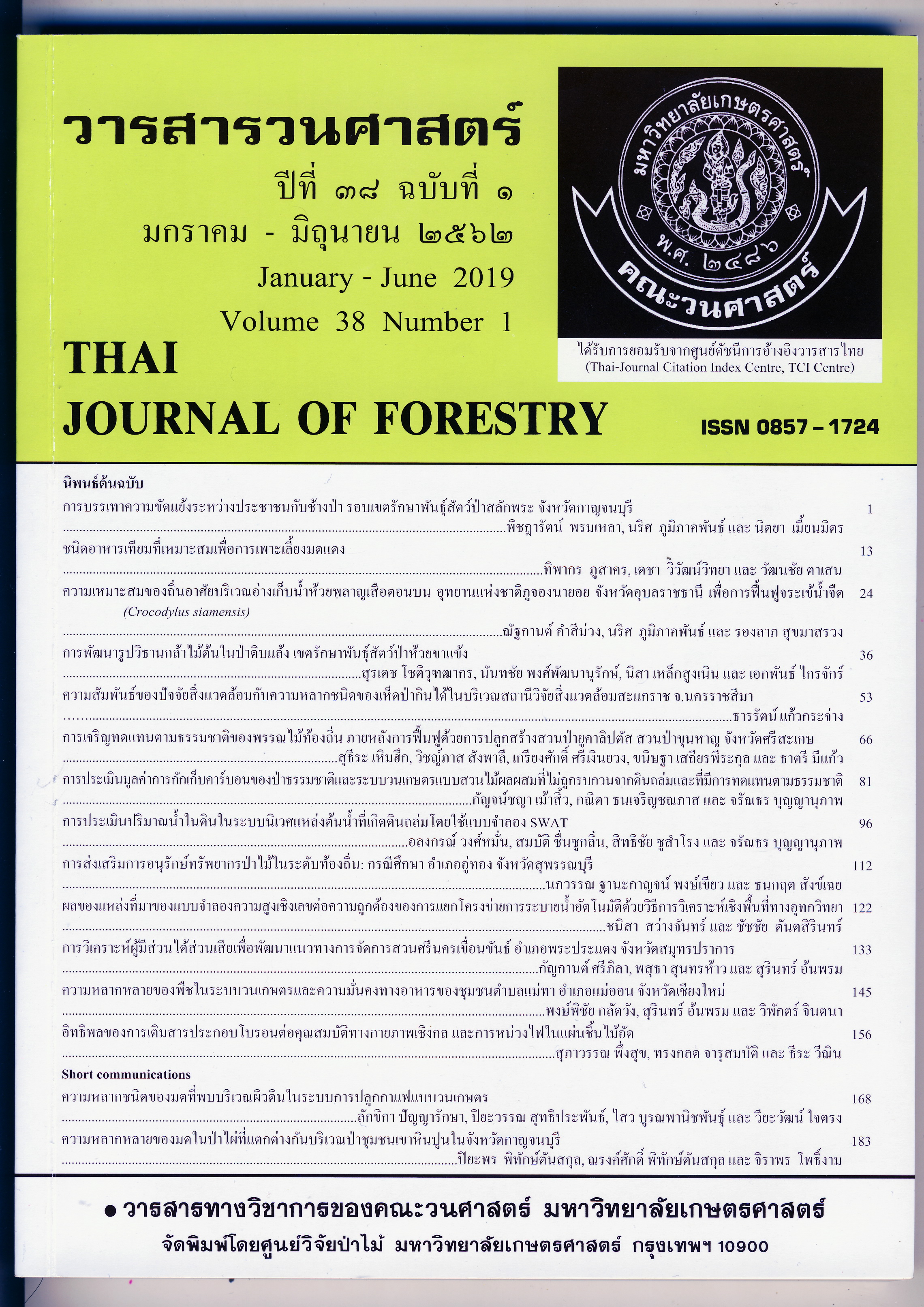การพัฒนารูปวิธานกล้าไม้ต้นในป่าดิบแล้ง เขตรักษาพันธุ์สัตว์ป่าห้วยขาแข้ง
Main Article Content
บทคัดย่อ
ตั้งแต่อดีตจนถึงปัจจุบันการศึกษาอนุกรมวิธานพืชของกล้าไม้ต้นประเทศไทยยังขาดแคลนรูปวิธานเพื่อจำแนกชนิดกล้าไม้ต้นด้วยเทคนิคอนุกรมวิธานพืชเชิงตัวเลข พบว่าเทคนิคดังกล่าวได้มีการพัฒนามากขึ้นตามลำดับ แต่เทคนิคนี้ก็ไม่ได้นิยมนำมาใช้ในการพัฒนารูปวิธานกล้าไม้ต้นเท่าที่ควรในประเทศไทย การศึกษานี้จึงมีเป้าหมายเพื่อศึกษาสันฐานวิทยาของกล้าไม้ต้นป่าดิบแล้งบางชนิดเพื่อนำมาพัฒนารูปวิธานกล้าไม้ต้นดังกล่าวโดยใช้เทคนิคทางอนุกรมวิธานพืชดั้งเดิม และเทคนิคอนุกรมวิธานพืชเชิงตัวเลข และเปรียบเทียบรูปวิธานที่ได้จากการพัฒนาตามเทคนิคทั้งสองในแง่ของความถูกต้องและการนำไปใช้ประโยชน์ การวิจัยนี้ได้รวบรวมเมล็ดไม้ทั้งหมด 30 ชนิด ซึ่งเป็นชนิดที่พบได้ทั่วไปในแปลงถาวรขนาด 50 เฮกแตร์ บริเวณป่าดิบแล้งในเขตรักษาพันธุ์สัตว์ป่าห้วยขาแข้ง โดยทำการเก็บเมล็ดไม้ต้นรอบแปลงถาวรดังกล่าว หลังจากนั้นทำการเพาะเมล็ดไม้ในเรือนเพาะชำเพื่อติดตามลักษณะสันฐานวิทยาในช่วงระยะงอกจนกระทั่งแตกใบแท้คู่แรก ลักษณะสันฐานวิทยานี้ได้ถูกนำไปใช้พัฒนารูปวิธานจำนวน 4 แบบ ได้แก่ 1) พัฒนารูปวิธานด้วยเทคนิคอนุกรมวิธานพืชเชิงตัวเลขโดยใช้เฉพาะลักษณะสัณฐานวิทยาเชิงปริมาณ 2) พัฒนารูปวิธานด้วยเทคนิคอนุกรมวิธานพืชเชิงตัวเลขโดยใช้เฉพาะลักษณะสัณฐานวิทยาเชิงคุณภาพ 3) พัฒนารูปวิธานด้วยเทคนิคอนุกรมวิธานพืชเชิงตัวเลขโดยใช้ทั้งลักษณะสัณฐานวิทยาเชิงปริมาณ และเชิงคุณภาพ และ 4) พัฒนารูปวิธานด้วยเทคนิคอนุกรมวิธานพืชดั้งเดิมโดยใช้ทั้งลักษณะสัณฐานวิทยาเชิงปริมาณ และเชิงคุณภาพ (จากการใช้ลักษณะสัณฐานวิทยาเชิงคุณภาพ 26 ลักษณะ และลักษณะสันฐานวิทยาเชิงปริมาณ 10 ลักษณะ รวมลักษณะสัณฐานวิทยาทั้งสิ้น 36 ลักษณะ) ผลการศึกษาพบว่าจำนวนลักษณะสัณฐานวิทยาที่ถูกนำมาใช้พัฒนารูปวิธานทั้ง 4 รูปแบบมีจำนวน 10 16 15 และ 15 ลักษณะ ตามลำดับ และมีค่าความถูกต้องของรูปวิธานร้อยละ 96.27 100 100 และ 100 ตามลำดับ การศึกษานี้ชี้ให้เห็นว่ารูปวิธานที่พัฒนามาจากทั้งเทคนิคการจัดทำรูปวิธานแบบดั้งเดิมและแบบเชิงตัวเลขโดยใช้เฉพาะลักษณะสัณฐานวิทยาเชิงคุณภาพมีความแตกต่างกันในแง่ความถูกต้องไม่มากนัก และมีความเหมาะสมสำหรับการเลือกนำรูปวิธานไปใช้จำแนกชนิดกล้าไม้ต้น รูปวิธานที่พัฒนาจากการศึกษานี้มีความสำคัญต่อการนำไปใช้จำแนกกล้าไม้ต้นในป่าดิบแล้งเพื่อนำไปต่อยอดการศึกษาวิจัยเชิงลึกทางพลวัตของนิเวศวิทยากล้าไม้ในป่าดิบแล้งของเขตรักษาพันธุ์สัตว์ป่าห้วยขาแข้ง
คำสำคัญ: สัณฐานวิทยา กล้าไม้ต้น ป่าเขตร้อน อนุกรมวิธานพืชเชิงตัวเลข อนุกรมวิธานพืชแบบดั้งเดิม
Downloads
Article Details
ข้าพเจ้าและผู้เขียนร่วม (ถ้ามี) ขอรับรองว่า ต้นฉบับที่เสนอมานี้ยังไม่เคยได้รับการตีพิมพ์และไม่ได้อยู่ในระหว่างกระบวนการพิจารณาตีพิมพ์ลงในวารสารหรือสิ่งตีพิมพ์อื่นใด ข้าพเจ้าและผู้เขียนร่วม (ถ้ามี) ยอมรับหลักเกณฑ์และเงื่อนไขการพิจารณาต้นฉบับ ทั้งยินยอมให้กองบรรณาธิการมีสิทธิ์พิจารณาและตรวจแก้ต้นฉบับได้ตามที่เห็นสมควร พร้อมนี้ขอมอบลิขสิทธิ์ผลงานที่ได้รับการตีพิมพ์ให้แก่วารสารวนศาสตร์ คณะวนศาสตร์ มหาวิทยาลัยเกษตรศาสตร์ กรณีมีการฟ้องร้องเรื่องการละเมิดลิขสิทธิ์เกี่ยวกับภาพ กราฟ ข้อความส่วนใดส่วนหนึ่ง หรือ ข้อคิดเห็นที่ปรากฏในผลงาน ให้เป็นความรับผิดชอบของข้าพเจ้าและผู้เขียนร่วม (ถ้ามี) แต่เพียงฝ่ายเดียว และหากข้าพเจ้าและผู้เขียนร่วม (ถ้ามี) ประสงค์ถอนบทความในระหว่างกระบวนการพิจารณาของทางวารสาร ข้าพเจ้าและผู้เขียนร่วม (ถ้ามี) ยินดีรับผิดชอบค่าใช้จ่ายทั้งหมดที่เกิดขึ้นในกระบวนการพิจารณาบทความนั้น”
เอกสารอ้างอิง
and C. Violle. 2011. When and how should
intraspecific variability be considered in
trait-based plant ecology? Perspectives in
Plant Ecology, Evolution and Systematics
13 (3): 217-225.
Breiman, L., J.H Friedman, R.A. Olshen and C.G. Stone.
1984. Classification and Regression Trees.
Wadsworth Publishing Company, USA.
Bunker, D.E. and W.P. Carson. 2005. Drought stress
and tropical forest woody seedlings: effect
on community structure and composition.
Journal of Ecology 93 (4): 794-806.
Bunyavejchewin, S., S.J. Baker, J. Lafrankie and P.S.
Ashton. 2004. Structure, history, and rarity
in a seasonal evergreen forest in Western
Thailand, pp. 145-158. In E.C. Losos andE.G. Leigh, eds. Tropical Forest Diversity
and Dynamism: Findings form a Large-
Scale Plot Network. University of Chicago
Press, Chicago.
Bunyavejchewin, S., Y. Chamlongrach, R. Buasalee
and P. Rayangkul. 2016. Trees & Forest
of Huai Kha Khaeng Wildlife Sanctuary.
The Rabbit in the Moon Foundation, Thailand.
Bunyavejchewin, S., J.V. LaFrankie, S.J. Baker, S.J.
Davies and P.S. Ashton. 2009. Forest Trees
of Huai Kha Khaeng Wildlife Sanctuary,
Thailand. National Parks, Wildlife and
Plant Conservation Department, Thailand.
Chamchumroon, V. 1997. The Morphological
Study and Identification of Some Woody
Plant Seedlings of Dry Evergreen Forest
at Khlong Plu, Huai Kha Kheng Wildlife
Sanctuary, Changwat Uthai Thani. M.S.
Thesis. Kasetsart University.
Connell, J.H. 1971. On the Role of Natural Enemies
in Preventing Competitive Exclusion in Some
Marine Animals and in Rain Forest Trees
In Dtnamics of Numbers in Poplations.
Wageningen, Netherland.
Duke, J. A. 1965. Keys for the identification of seedlings
of some prominent woody species in eight
forest types in Puerto Rico. Annals of the
Missouri Botanical Garden 52 (3): 314-350.
Forest Restoration Research Unit [FORRU]. 2000.
Tree Seed and Seedling for Restoring
Forest in Northern Thailand. Chiang Mai
University, Thailand.
Hellum, A.K., P. Pukittayacamee, M. Kashio and S.
Kijkar. 2000. A Field Guide to Some Tree
Seedlings in Thailand. Techpress Books,
Bangkok.
Hubbell, S.P. and R.B. Foster. 1986. Commonness
and rarity in a neotropical forest: implications
for tropical tree conservation, pp. 205-231.
In M.E. Soule, eds. Conservation Biology:
The Science of Scarcity and Diversity.
Sinauer Associates, Sunderland.
Janzen, D.J. 1970. Herbivores and the number of tree
species in tropical forests. The American
Naturalist 104 (940): 501-528.
Mulumba, J.W. and E. Kakudidi. 2010. Numerical
taxonomic study of Acacia senegal (Fabaceae)
in the cattle corridor of Uganda. South
African Journal of Botany 76 (2): 272-278.
Nair, P.K.K. 1980. Modern Trends in Plant
Taxonomy. Vikas Publishing House, New
Delhi Sahibabad.
Ng, F.S.P. 1991. Manual of Forest Fruits, Seeds
and Seedlings. Forest Research Institute
Malaysia, Malaysia.
Nozzolillo, C. 1977. Identification of Vicia seedlings.
Canadian Journal of Botany 55 (18):
2439-2462.
Osborne, D.V. 1963. A numerical representation
for taxonomic keys. New Phytologist 62
(1): 35-43.
Pérez-Harguindeguy, N., S. Díaz, E. Garnier, S. Lavorel,
H. Poorter, P. Jaureguiberry, M.S. Bret-Harte,
W.K. Cornwell, J.M. Craine, D.E. Gurvich,
C. Urcelay, E.J. Veneklaas, P.B. Reich, L.
Poorter, I.J. Wright, P. Ray, L. Enrico, J.G.
Pausas, A.C. de Vos, N. Buchmann, G. Funes,
F. Quétier, J.G. Hodgson, K. Thompson,
H.D. Morgan, H. ter Steege, L. Sack, B.
Blonder, P. Poschlod, M. V. Vaieretti, G.
Conti, A.C. Staver, S. Aquino and J.H.C.
Cornelissen. 2013. New handbook for
standardised measurement of plant functional
traits worldwide. Australian Journal of
Botany 61 (3): 1-167.
R Core Team. 2016. R: A Language and Environment
for Statistical Computing. R Foundation for
Statistical Computing. Available Source:
https://www.R-project.org/, November 25,
2016.
Sarwar, G.R. and M. Qaiser. 2011. A numerical
taxonomy of the genus Sedum L., from
Pakistan and Kashmir. Pakistan Journal
of Botany 43 (2): 753-758.
Schupp, E.W. 1992. The Janzen-Connell model for
tropical tree diversity population implications
and the importance of spatial scale. The
American Naturalist 140 (3): 526-530.
Sneath, P.H.A. 2015. Numerical Taxonomy. Available
Source: https://onlinelibrary.wiley.com/doi/
abs/10.1002/9781118960608.bm00018,
August 1, 2018.
Sneath, P.H.A. and R.R. Sokal. 1973. Numerical
Taxonomy: The Principles and Practice of
Numerical Classification. W. H. Freeman
and Company, San Francisco.
Srithong, K., T. Jongjitvimol and S. Petchsri. 2016.
Numerical taxonomy of landraces rice in lower
northern Thailand. In The 10th Botanical
Conference of Thailand. 52-65. Department
of Biological Science, Faculty of Science,
Ubon Ratchathani University.
Therneau, T., B. Atkinson and B. Ripley. 2018.
Recursive Partitioning for Classification.
Available Source: https://cran.r-project.org/
web/packages/rpart, Febuary 23, 2018.
Valentine, D.H. and A. Love. 1958. Taxonomic and
biosystematic categories. Brittonia 10 (4):
153-166.


